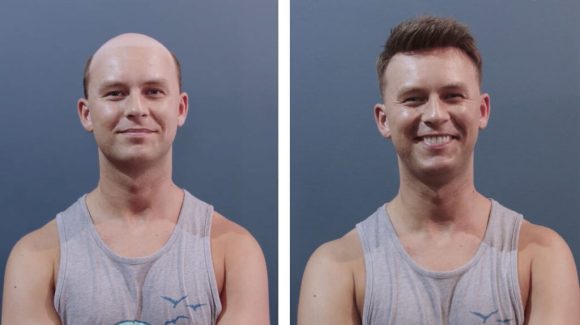22 Tips To Stop Hair Loss
How To Stop Hair Loss - Top Tips from Cochrane & Co Hair Replacement Specialists in London
For many men, hair loss is a natural part of growing older. For others, men and women alike, it’s an unexpected and unwelcome change. But one thing’s for sure – it’s here to stay. Male pattern hair loss in particular is very common indeed. It affects more than 6.5 million men in the UK – about one in ten – and perhaps as many as 66% of men in the United States by the time they’re 30. This latter fact is supplied by the American Hair Loss Association (which is actually a thing!).
Hair loss in women is also more common than you might think. Perhaps as many as one in twenty women under 30 will experience female pattern hair loss.
What causes hair loss in men and women? Excessive hair fall in women tends to be more likely to be genetic, passed down from either side of the family. From the late teens onwards, female pattern hair loss – also known as androgenetic alopecia – can come into effect. Male pattern baldness is also usually genetic. Alopecia areata is an autoimmune disease which affects perhaps 15 out of every 10 000 people in the UK.
It’s suspected to be genetic as well, even though the true source of the disorder – which results in the hair follicles being attacked by the sufferer’s own immune system – isn’t known. In both sexes hair loss can also occur due to hormone imbalances, such as where testosterone is converted into Dihydrotestosterone (DHT), which causes hair follicles to shrink.
In the case of women, this can also be due to the presence of excess male hormones called androgens. A common indicator of when this is the cause of hair loss in women is when the pattern of baldness resembles that of a man. Both men and women can also experience hair loss due to stress (the most common of which is telogen effluvium) caused by major events in their lives, such as relationship break-ups or losing a job.
Skin disorders, medical treatments, and the aforementioned hormonal imbalances can also be leading factors. Identifying the causes of hair thinning or baldness is the first step in any prevention or treatment.
Hobbies, sports, and other ways of reducing stress will be great at combating certain causes, for example. But others may require different treatment…
1. Always let a doctor diagnose the cause of baldness
It’s always best to talk to a medical healthcare professional about your hair loss.
The causes of bald patches are many and varied, and simply assuming the problem is genetic is not always the safest approach.
Low levels of iron or protein, thyroid problems, and many more health issues can cause hair to be shed.
That’s not to say that a doctor – or more specifically a dermatologist – will be able to take a quick look at your head and discern exactly what the problem is.
It can take months or even years to correctly diagnose the issue.
This is why fast action is necessary, so as soon as you see thinning hair, you need to visit a dermatologist.
They can perform a scalp biopsy to make sure that the problem isn’t caused by anything serious.
When selecting a doctor, don’t just choose the one that a Google advert suggests in your area either.
If possible consult your GP or family doctor for advice.

2. Don’t believe the hype – there is no miracle cure for hair loss
Because of the sometimes sudden onset of thinning hair – or at least the sudden shock when you notice it! – it can be tempting to hope that there is an equally quick cure. Bad news time: There isn’t. At least… not yet.
Don’t listen to the sort of late night television adverts or magazine articles promising the latest “miracle pill.” Many of these haven’t been scientifically tested, and in some cases can result in some pretty nasty side effects.
But there are some treatments which are showing some promise, even if none of them can be counted as a real “hair loss cure.”
Check out some of the best in the tips that follow…
3. There are some exciting developments in creams and shampoos
Rogaine – the active ingredient in which is known as Minoxidil – does seem to stimulate hair growth, but the precise reason for this is not currently understood.
It seems to have something to do with allowing the growth phase of the hair to last for longer.
Using Rogaine won’t permanently restore you to a full head of hair, but it does seem to show some hair regrowth in many cases.
But the process takes up to half a year or more to work, and can actually reduce the amount of hair on your head for the first few months.
It is the only medication which the FDA in America approved for treating female pattern hair loss, but it’s always worth consulting your doctor before proceeding with any kind of treatment like this.
4. Hair loss tablets are for the brave – and well-informed!
The active ingredient in Propecia is called finasteride, and can prevent and even revert male pattern hair loss. It works by slowing the conversion of testosterone into DHT. There are side effects however – for men, and especially for women who are pregnant or who are intending to have a child.
Again, a course of treatment should never be started without first consulting a knowledgeable professional.
5. Laser treatments for hair loss
Various combs and even helmets that use laser light to stimulate the hair growth cycle are available on the market. Not approved for use in all cases – and not usually for hair loss in women – there is some evidence to show that laser treatment can stimulate hair growth.
6. Check out the latest hair replacement systems
Hair replacement systems like those from Cochrane & Co Hair Replacement in London offer an alternative to traditional hair replacement.
A micro-thin layer containing natural hair is semi-permanently bonded to your scalp.
This is NOT a surgical process, so there’s no scarring. And the line between the system and the rest of your scalp is invisible in all of the evidence that we’ve seen. This shows some real potential as a non-surgical hair replacement option.
Because it’s natural hair, you’ll need to shampoo it, but you’ll style it just like it was your own!

7. Treat wet hair with care
Anything that puts unnecessary stress on the hair or the scalp should be avoided in your general hair care routine.
But this is especially vital when you’re dealing with wet hair…
Wet hair breaks much more easily than dry or semi-dry hair, as you’ll probably know if you’ve ever wielded a comb straight after coming out of the shower!
You might want to try some of the following tips for hair loss prevention: Don’t comb your hair while it’s wet. Take a look at your comb if you’ve ever done this.
You’ll see significantly more strands there than you might expect… or like! Dry with a soft towel – don’t scrub! Rubbing at your hair – especially while it’s wet – will probably lead to hair breakage. Use the towel to soak the water out rather than scrubbing your head dry. Gently detangle first. Try using a wide-toothed comb to start the detangling process. You can then scale down to a fine-toothed comb to style.
8. Choose your hair care products with CARE
Despite big claims on many bottles, lots of hair care products aren’t actually beneficial for you if you’re interested in safeguarding your locks.
Be exceedingly careful which products and devices you use. For example, consider:
Washing with an anti-dandruff shampoo.
Specifically one that contains ketoconazole or zinc pyrthione.
Ketoconazole is an antifungal, while zinc pyrthione is both antifungal and antibacterial.
Both will fight dandruff while reducing the production of testosterone.
Avoiding excessive blow drying or use of curling irons.
These are common causes of increased hair loss, especially in women where their use is more common.
9. Look out for your diet
It’s a point that’s often overlooked by sufferers of thinning hair, but if you’re looking for tips on how to prevent hair loss naturally, improving your diet can work wonders.
The main key point is to avoid sugar, fried, and high-fat foods.
This is all about reducing the amount of testosterone which is released in the body, and the conversion of testosterone to DHT.

10. Get the right vitamins
This is important for your general health of course, but vitamins are vital if you want to get your hair back naturally.
Keep an eye on your levels of:
Vitamin A – this encourages healthy cell growth throughout the body, including in the hair and scalp cells.
B vitamins, especially B12 – assist in the function of haemoglobin, which is the transport system for oxygen within the body. Oxygen needs to get to the hair constantly in order for it to grow.
Vitamin C – regular vitamin C intake is important because it’s needed for the production of collagen, a connective tissue that’s in hair as well as other of your body.
Zinc – zinc deficiency is a common cause of hair loss and dandruff.
Protein – this is the main building block in hair, but it’s important to remember that high-fat foods lead to higher proportions of testosterone in the body. Getting your protein from fish is a great plan.
11. Stay hydrated
Drink lots of water to stay well hydrated. It’s vital for the health of every cell in your body, including your hair.
Guidelines for the amount that you should consume vary, but a good estimate for how much water we should drink a day is around eight cups or two litres.
12. Check your iron levels
Ferritin is the medical term for iron storage. Young women in particular often suffer from lower iron levels.
Consider an iron supplement if your doctor advises it. Low levels of iron will cause hair shedding.
13. Get a lot of healthy exercise
A common concern is that the need to shower and shampoo more often after exercise feels like the sort of thing that might have a negative effect on hair.
It’s not the case though: The better shape you’re in, the more your hair will show it.
Sport, or exercise like yoga that’s also de-stressing, are recommended.
More shampooing when washing the sweat off afterwards is actually better for your hair – as long as you follow the tips above to avoid the dangers of treating wet hair too roughly.

14. Channel your inner action hero, gentlemen!
A balding man has a clear choice in front of him in the event a suitable treatment can’t be found or isn’t desired:
An awkward comb-over or other similarly “resistant” style…
Or the shaven head.
Trying to resist the changes in your hair or worrying about them constantly will lead to more stress – one of the things that you’re actively trying to avoid! (See Tip #20)
Chat to your barber or stylist if you’re considering it. Nine times out of ten? They’ll recommend the taller and more masculine look that a shaven head will give you.
Imagine Vin Diesel with long, feminine locks, or Jason Statham if he tried to stick it out with longer hair! In fact, Statham is a great example of how to deal with hair loss in men: he’s shaved his head and is usually seen with significant stubble or a trimmed beard.
This draws your eye further down the head, away from any potential balding areas.
15. Own a new look, ladies!
It’s completely unfair that while a balding man is seen as more manly, a balding woman is often seen as less feminine.
That said, have you seen Charlize Theron in the reboot of the movie Mad Max? Check it out if you’re looking for a woman with a shaven head who is very much ready to kick some ass instead of being bothered by it.
Or why not try checking out some famous women who sport shaved or shorter hair by choice? Halle Berry has longer hair in some of her film roles, but in her private life she has very short hair indeed. In the film Nappily Ever After she plays a character who is actively losing her hair.
16. Is your colouring wreaking havoc with your hair?
Female hair loss shouldn’t necessarily be a reason to stop colouring or perming hair. In fact, the more shampooing you do, the more of a beneficial effect you’re likely to get.
In many cases though, bleaching and colouring do exacerbate hair fall. This is another reason to consult an expert dermatologist or endocrinologist – you need someone who can advise you on whether that colouring is contributing to your hair loss. That said, the wrong style – scraped back ponytails, pigtails, braids, hair extensions, or anything tight – are definitely to be avoided. You don’t want to stress out the hair follicles by pulling on them.
17. What’s your scalp health like? Get a massage to make it better!
A head or scalp massage will increase blood flow to your scalp and hair follicles.
This is great for increasing the health of the roots, making them stronger.
It’s also fantastic at opening up blood vessels in the skin so they can take in more nutrients.
Have one of these bad boys weekly and you’re likely to see some serious benefits.
Not least of which is that a massage is also a great option for Tip #20…
18. Can hot oil treatment really work?
It can sound like a strange practice, but the Greeks and the Romans both used to oil their hair, and various ancient Indian medical practitioners swore by hot oil as a hair loss treatment.
Lavender oil, olive oil, almond oil, coconut oil, geranium oil, canola oil, sesame oil, and many others can all be used when gently heated, massaged into your scalp, and then left there inside a shower cap for about an hour.
19. Dandruff dandruff dandruff…
If that’s all you seem to see, it’s time to start asking the question: does dandruff cause hair loss?
Well, the evidence seems to suggest not directly. But the constant itching and scratching that accompany really bad dandruff certainly don’t help. In addition, hair loss remedies which include minoxidil often lead to a dryer scalp and more dandruff, perpetuating the cycle! The main cause of dandruff is a very dry scalp, which can usually be treated with massage, various over-the-counter dandruff shampoos (see Tip #8), and regular washing – we’re talking every day.
20. Stress management
Directly responsible for hair loss in both men and women, stress is a factor that’s unique to you and needs to be dealt with in the way that suits you best.
Many people find meditation, yoga, or tai chi to be very relaxing, but for you it might be as simple as taking time out of your day to read or relax without being constantly bombarded with things to do. Stress relief is one of the most important things you can focus on for relieving the symptoms of hair loss.
21. Prevent hair loss naturally with herbs and remedies
As well as a healthy diet and exercise regimen, natural herbs have been used in many cultures across the world to prevent or halt hair loss.
Native Americans used yucca plant roots, everyone from the Ancient Egyptians onwards used Aloe Vera, while traditional Indian medicine recommends using Bhringaraj or Amla.
22. Quit the habit
Smoking, caffeine, and fizzy drinks stop your hair from growing to its maximum potential. Cutting them out is potentially one of the biggest steps you can make towards a healthy lifestyle and healthy hair.

